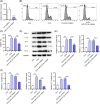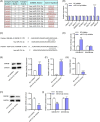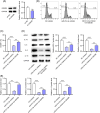MicroRNA-214-3p facilitates M2 macrophage polarization by targeting GSK3B
- PMID: 35005835
- PMCID: PMC11896522
- DOI: 10.1002/kjm2.12487
MicroRNA-214-3p facilitates M2 macrophage polarization by targeting GSK3B
Abstract
Allergic rhinitis (AR) is a chronic inflammatory disease of the nasal mucosa. M2 macrophage polarization can reduce inflammation and repair tissue injury during AR development. Studies have substantiated the involvement of miRNAs in AR pathogenesis. Herein, the molecular mechanism of miR-214-3p in AR development was explored. To mimic the AR environment, ovalbumin (OVA) was used to treat macrophages. MiR-214-3p and glycogen synthase kinase 3 beta (GSK3B) expression in nasal mucus tissues and macrophages was assessed by RT-qPCR. The M2 phenotypic signature of CD206 in macrophages was assessed by flow cytometry. The protein expression of GSK3B and M2 macrophage markers (ARG-1 and IL-10) was evaluated by western blotting. The correlation between miR-214-3p and GSK3B was validated by a luciferase reporter assay. We found that miR-214-3p was overexpressed in macrophages and nasal mucus tissues from AR patients. MiR-214-3p facilitated M2 polarization of macrophages upon OVA stimulation. Mechanistically, miR-214-3p targeted the GSK3B 3' untranslated region in macrophages. In addition, GSK3B was downregulated in macrophages and nasal mucus tissues from AR patients. In rescue assays, GSK3B downregulation reversed the inhibitory effects of miR-214-3p silencing on M2 polarization of macrophages treated with OVA. Overall, miR-214-3p facilitates M2 macrophage polarization by targeting GSK3B.
Keywords: AR; GSK3B; M2 macrophage polarization; MiR-214-3p.
© 2022 The Authors. The Kaohsiung Journal of Medical Sciences published by John Wiley & Sons Australia, Ltd on behalf of Kaohsiung Medical University.
Conflict of interest statement
The authors declare no conflict of interests.
Figures





Similar articles
-
Serum exosome-derived miR-146a-3p promotes macrophage M2 polarization in allergic rhinitis by targeting VAV3 via PI3K/AKT/mTOR pathway.Int Immunopharmacol. 2023 Nov;124(Pt B):110997. doi: 10.1016/j.intimp.2023.110997. Epub 2023 Sep 30. Int Immunopharmacol. 2023. PMID: 37783052
-
Bone marrow mesenchymal stem cell-derived exosomal microRNA-124-3p attenuates neurological damage in spinal cord ischemia-reperfusion injury by downregulating Ern1 and promoting M2 macrophage polarization.Arthritis Res Ther. 2020 Apr 9;22(1):75. doi: 10.1186/s13075-020-2146-x. Arthritis Res Ther. 2020. PMID: 32272965 Free PMC article.
-
Downregulation of GSK3B by miR-132-3p Enhances Etoposide-Induced Breast Cancer Cell Apoptosis.Ann Clin Lab Sci. 2021 May;51(3):285-294. Ann Clin Lab Sci. 2021. PMID: 34162557
-
The impact of non-coding RNAs on macrophage polarization.Biomed Pharmacother. 2021 Oct;142:112112. doi: 10.1016/j.biopha.2021.112112. Epub 2021 Aug 27. Biomed Pharmacother. 2021. PMID: 34449319 Review.
-
MiRNA-Mediated Macrophage Polarization and its Potential Role in the Regulation of Inflammatory Response.Shock. 2016 Aug;46(2):122-31. doi: 10.1097/SHK.0000000000000604. Shock. 2016. PMID: 26954942 Free PMC article. Review.
Cited by
-
Spinal cord injury dysregulates fibro-adipogenic progenitors miRNAs signaling to promote neurogenic heterotopic ossifications.Commun Biol. 2023 Sep 12;6(1):932. doi: 10.1038/s42003-023-05316-w. Commun Biol. 2023. PMID: 37700159 Free PMC article.
-
miR-214-3p inhibits LPS-induced macrophage inflammation and attenuates the progression of dry eye syndrome by regulating ferroptosis in cells.Genes Genomics. 2025 Feb;47(2):183-195. doi: 10.1007/s13258-024-01598-4. Epub 2024 Nov 20. Genes Genomics. 2025. PMID: 39567416
-
The Extracellular Vesicle-Macrophage Regulatory Axis: A Novel Pathogenesis for Endometriosis.Biomolecules. 2023 Sep 12;13(9):1376. doi: 10.3390/biom13091376. Biomolecules. 2023. PMID: 37759776 Free PMC article. Review.
-
Application of Extracellular Vesicles in Allergic Rhinitis: A Systematic Review.Int J Mol Sci. 2022 Dec 26;24(1):367. doi: 10.3390/ijms24010367. Int J Mol Sci. 2022. PMID: 36613810 Free PMC article.
-
Large-scale computational modelling of the M1 and M2 synovial macrophages in rheumatoid arthritis.NPJ Syst Biol Appl. 2024 Jan 26;10(1):10. doi: 10.1038/s41540-024-00337-5. NPJ Syst Biol Appl. 2024. PMID: 38272919 Free PMC article.
References
-
- Lee BW, Lee CS, Lim ER, Tham AC. Intranasal steroid use and satisfaction in allergic rhinitis: a cross‐sectional study from an Asian perspective. ORL J Otorhinolaryngol Relat Spec. 2021:1–7. - PubMed
MeSH terms
Substances
LinkOut - more resources
Full Text Sources
Research Materials
Miscellaneous

